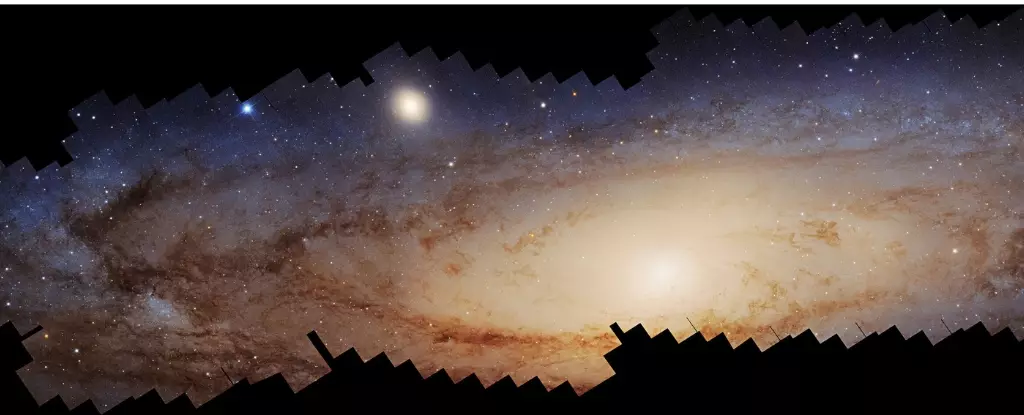The Andromeda Galaxy, known scientifically as M31, stands as the closest spiral galaxy to our own Milky Way, making it a focal point of cosmic curiosity for astronomers and stargazers alike. To the naked eye, under perfect conditions, Andromeda reveals itself as a faint grey smudge against the backdrop of the night sky—not a dazzling spectacle, but a gateway to understanding the wider universe. Despite being mere shadows of light, these observations mark the farthest distances we can perceive without the aid of telescopes, solidifying Andromeda’s place as a significant subject of interest in galactic studies.
With advancements in technology, particularly the Hubble Space Telescope, we have been granted a window into the mesmerizing depths of Andromeda. Over a decade, Hubble meticulously captured data, resulting in a monumental 2.5-gigapixel panorama that showcases approximately 200 million individual stars. The sheer scale and detail encapsulated in this cosmic tapestry allow scientists to glean insights, not just about Andromeda but also about our own galaxy, the Milky Way.
Both Andromeda and the Milky Way belong to the family of barred spiral galaxies, an essential classification that informs us about their evolutionary paths. The observations collected from Andromeda serve as a proxy to interpret our galactic dynamics, providing scientists with invaluable data. “The detailed information we can gather through Hubble requires an understanding of the general structure of M31,” explains Ben Williams, a leading researcher in the field. Such intricate examinations help uncover the underlying processes of star formation, metal enrichment in star populations, and the overall cosmic environment these galaxies inhabit.
Through high-resolution imaging and dedicated observation phases called PHAT (Panchromatic Hubble Andromeda Treasury) and PHAST (Panchromatic Hubble Andromeda Southern Treasury), researchers have significantly advanced their knowledge of Andromeda. These twin projects have meticulously revealed not just the stars but also the surrounding satellite galaxies and even the interstellar dust that plays a crucial role in cosmic ecology. Recent studies published in the Astrophysical Journal shed light on these efforts, portraying a galaxy rich in structure but complex in its formation history.
While Andromeda’s splendour is palpable, its history tells a tale of cosmic tumult. Each survey has alluded to enriching details about the galaxy’s past, particularly in the southern hemisphere, which has historically received less scrutiny. Astronomers have observed that this portion of the galaxy exhibits disturbances indicative of past merger events. M32, a dwarf galaxy located near Andromeda, serves as a key clue in unraveling its dynamic history. This small yet fierce entity may embody remnants of a larger galaxy that collided with Andromeda eons ago, a poignant reminder of the violent dance of cosmic structures.
The Giant Southern Stream, a vast filament of stars, further underscores Andromeda’s combative history; it acts as a stellar remnant from previous galactic interactions, rendering invaluable data about star metallicity and evolutionary timings. “Andromeda is like a train wreck of galactic evolution,” asserts Daniel Weisz. “It is reshaped and transformed by encounters with other galaxies.” Such dynamics provide vital lessons for understanding not only Andromeda’s past but also the future of our own spiral home.
While current studies illuminate many hidden facets of Andromeda, the quest for knowledge is ongoing. Upcoming missions, particularly the anticipated launch of NASA’s Nancy Grace Roman Space Telescope, promise to further enrich our understanding of M31. The Roman telescope, set to cover vast swathes of the cosmic canvas in infrared wavelengths, could potentially unveil new dimensions of star formation and evolution. In just a single observation, it is projected to capture the equivalent of hundreds of high-resolution images, allowing a more comprehensive analysis of features like the Giant Southern Stream.
Astrophysical research is inherently an act of storytelling—one that crosses the boundaries of time and space, linking our existence with the majestic rhythms of the universe. As we continue to explore the Andromeda Galaxy and unravel its secrets, we inevitably peel back layers of our own cosmic identity. In this dance of discovery between the Milky Way and Andromeda, we are reminded that the skies above are not just empty space but a rich tapestry housing stories of creation, transformation, and the complex interplay of cosmic forces. It is a pursuit that not only tells us about our galactic neighbor but also redefines the narrative of humanity’s place in the universe.

